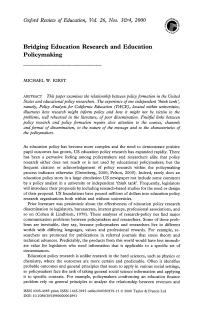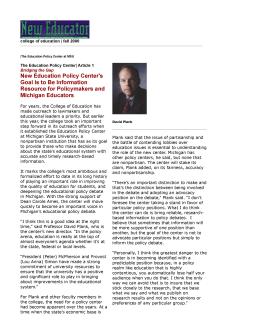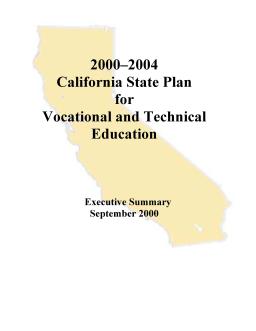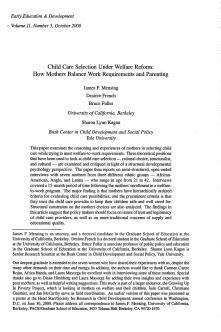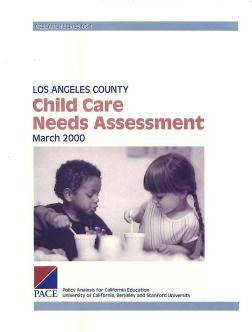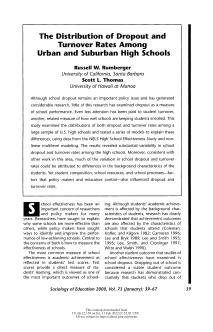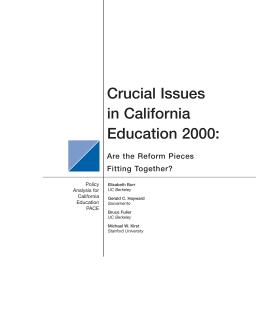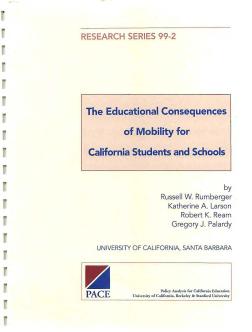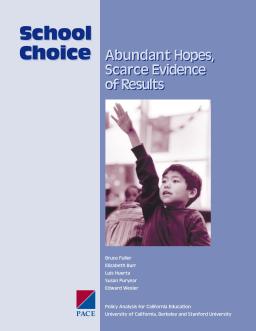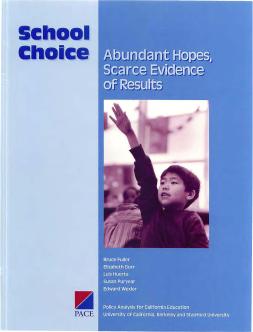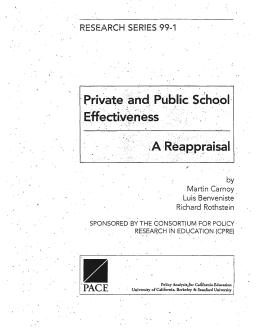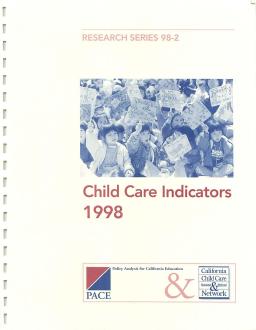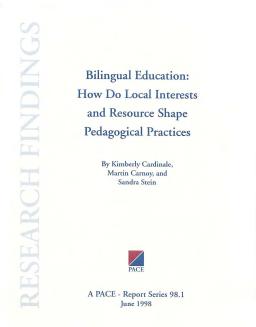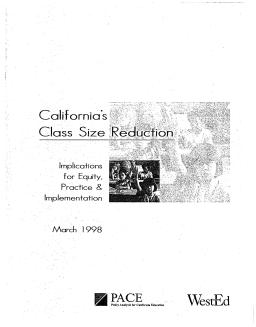Published
Summary
Spring 2001 PACE Newsletter, Volume 3, Number 1.
Published
Summary
This paper examines the relationship between policy formation in the United States and educational policy researchers. The experience of one independent 'think tank', namely PACE, located within universities, illustrates how research might inform policy and how it might not be victim to the problems, well rehearsed in the literature, of poor dissemination. Fruitful links between policy research and policy formation require close attention to the sources, channels, and format of dissemination, to the nature of the message, and to the characteristics of the policymakers.
New Education Policy Center's Goal Is to Be Information Resource for Policymakers and Michigan Educators
Published
Summary
Michigan State University's College of Education has established the nonpartisan Education Policy Center to provide lawmakers and educational leaders with accurate, research-based information to improve the state's educational system. With the support of the university's resources, the center aims to play an important role in deepening the policy debate and bringing about improvements in the system. The center was established due to a lack of systematic communication between researchers and policymakers in Michigan.
Executive Summary
Published
Summary
The California State Plan for Vocational and Technical Education 2000-2004 was developed with PACE's help, linking vocational education to other aspects of California's education system. The plan aimed to improve academic learning through strong vocational programs and better linkages between the world of schooling and the world of work. The summary covers the plan's context, guiding principles, vocational education, accountability, evaluation, and Tech-Prep Education.
How Mothers Balance Work Requirements and Parenting
Published
Summary
This paper examines how mothers select childcare to meet welfare-to-work requirements. Interviews with seven mothers from different ethnic groups show that trust in childcare providers to keep their children safe is the most important criterion. Structural constraints on their choices are also analyzed. The findings suggest that policymakers should focus on trust and legitimacy of childcare providers in addition to supply and educational quality.
Published
Summary
Governments are expanding the availability of portable child-care vouchers to boost working parents' purchasing power, rather than simply building more child-care facilities. Despite this, parents in poor communities still have limited choices due to cost and supply. Many eligible parents are not using subsidies, resulting in high out-of-pocket expenses for child care. Low-income working mothers make tough choices, working more hours or relying on informal providers, resulting in several transitions for children throughout the week, which experts suggest is not good for young children.
Published
Summary
A study conducted for the Los Angeles County Department of Public Social Services aimed to determine the supply and demand of licensed childcare in the county, with a focus on low-income communities and special types of care. The survey analyzed data at three levels: county-wide, service planning areas, and supervisorial districts. Results showed disparities in childcare supply across the county, with shortages in special types of care and little information on where childcare is needed.
Mothers Balance Work and Child Care Under Welfare Reform—Executive Summary
Published
Summary
A four-year study aimed to learn how welfare reform affects children's upbringing and development, showing early warning signals such as low-quality childcare and social isolation among women. The report provides a baseline picture for 948 families across three states and suggests an unfinished agenda for cash assistance and family support programs to lift children out of poverty.
Are the Reform Pieces Fitting Together?
Published
Summary
"Crucial Issues in California Education 2000" is a PACE publication that offers an analytical overview of California education through in-depth research projects contributed by experts statewide. It provides the latest data analysis and overall strategic recommendations on a wide variety of issues, from childcare to universities, making it a unique source for policy analysis. The volume is the largest in the history of the series, bringing together numerous reports on components of California education in one source.
Published
Summary
The reauthorization of the Elementary and Secondary Education Act provides an opportunity to reconsider the federal role in teacher professional development. The largest federal professional development fund is the Eisenhower program. Lessons from Eisenhower and contemporary research suggest that federal funds should be focused exclusively on subject matter knowledge and pedagogy and accountability should be based on assessment of student learning. The purpose is to generate discussion on how to more effectively use federal dollars to improve student achievement.
Published
Summary
This paper examines high school dropout and turnover rates in the US and tests models to explain the differences using data from the NELS High School Effectiveness Study. Variability was found among high schools, with much of the variation attributed to differences in student characteristics, but factors such as school resources and processes also influenced rates. Dropout and turnover rates are measures of school performance that policymakers and educators can influence.
Are the Reform Pieces Fitting Together?: Executive Summary
Published
Summary
California’s education system has undergone many reforms, with new mandates from policymakers threatening to overwhelm educators. The new accountability system tracks schools’ effectiveness and allocates carrots or sticks. Schools still struggle with reducing class sizes and finding enough qualified teachers. While California has made significant policy initiatives, the challenge is whether the puzzle pieces of reform fit together into a coherent “theory of action.” The issue of policy coherence must be addressed to energize teachers and bring forth more stimulating classrooms and pedagogy.
The Influence of Family Structure, Parental Practices, and Home Language
Published
Summary
Latino children are less likely to be enrolled in preschools, even after considering household income and maternal employment. Social factors such as language, child-rearing beliefs, and practices also impact center selection. African American families participate at higher rates, while lower enrollment for Latinos is linked to Spanish-speaking households and cultural preferences. Center selection is part of a broader parental agenda of acculturation to middle-class Anglo commitments to prepare children for school.
California's School Voucher Initiative—Proposition 38
Published
Summary
Proposition 38 allows parents in California to obtain a state chit worth $4,000 and move their child from public to private school, which would significantly affect school financing. This policy brief addresses six key questions about the proposal, including its differences from the 1993 voucher initiative, which families would benefit, how it would impact school spending and taxpayers, and the success of voucher experiments in raising achievement.
Published
Summary
This study examines student mobility in California, particularly at the secondary level. It investigates the incidence, consequences, and causes of non-promotional school changes and offers strategies to address the issue. It also draws on an extensive dataset from various sources, including surveys and interviews with California students, parents, and schools. The findings highlight the negative impact of student mobility on educational achievement and suggest that families, schools, community agencies, and policymakers should take action to mitigate its harmful effects.
Published
Summary
Student mobility, or non-promotional school changes, is a widespread problem that harms students' educational achievement. This report examines the incidence, consequences, and causes of mobility among California students and schools, drawing on surveys of students, parents, and schools, interviews with mobile students and their parents, and interviews with school administrators, counselors, and teachers. The report summarizes the findings on the causes and consequences of mobility and offers strategies for reducing needless mobility and mitigating its harmful effects.
Published
Summary
Spring 1999 PACE Newsletter, Volume 2, Number 1.
Abundant Hopes, Scarce Evidence of Results—Executive Summary
Published
Summary
Public education in the US is widely criticized and everyone wants to reform it, but there's no consensus on the best strategy for improvement. This report focuses on school choice, a reform avenue gaining steam in California and the US, to explore policies and institutional changes that can boost children's learning.
Published
Summary
The report provides local and state-level policymakers with data on the current capacity of the childcare system and indicators of future growth in family demand. It includes county-level aggregates, new data on job-related income, and estimates for families earning less than 75% of California's median income. It also adds new data on the size of the childcare workforce in each county, revealing disparities in the availability of childcare services and the number of local residents depending on the industry for their livelihood.
Abundant Hopes, Scarce Evidence of Results
Published
Summary
Public education receives criticism from various stakeholders. Despite satisfaction with local elementary schools, overall quality concerns prevail. There is no consensus on the best approach to improve schools. PACE report investigates school choice, which is a reform strategy gaining popularity in California and beyond.
A Reappraisal
Published
Summary
This report challenges the belief that public schools are ineffective due to a lack of accountability for producing high academic achievement. Some argue that private management is necessary for improvement, but this report seeks to analyze the range of responses that schools have to accountability and determine whether market forces are necessary for improvement.
Preliminary Figures
Published
Summary
California's childcare system lacks planning capacity and data on supply and demand. The Child Care Indicators 1998 report provides early indicators of supply and demand for all zip codes statewide, but zip codes may not reflect local residents' own definition of their community. Public funding for childcare and preschool programs will double in California between 1996 and 1999, but targeting new funding to areas with the greatest need remains a challenge.
How Do Local Interests and Resources Shape Pedagogical Practices?
Published
Summary
Bilingual education implementation varies by district due to discourse and policies. Four issues affecting implementation are teacher recruitment, "ghettoization" of bilingual education, race relations, and community consensus. National debates impact local administrative actions, defining bilingual education practice. The report analyzed four California school districts to show the impact of these four issues on program design.
A Study of Eight States and the District of Columbia
Published
Summary
This report presents the results of a study investigating the impact of charter schools on school districts, how they responded, and whether they experienced systemic change due to charter laws. The study focused on eight US states and the District of Columbia and included case studies of 25 affected school districts. The research was funded by The Saint Paul Foundation and conducted in 1997, six years into the charter school experiment. PACE hosted the study.
Implications for Equity, Practice, and Implementation
Published
Summary
In 1996, CA launched a $1 billion class size reduction (CSR) initiative to improve early literacy. The initiative provides $800 per student to schools reducing class size to 20 or fewer in first, second, and/or third grade, and kindergarten. CSR was funded due to a state revenue surplus and the belief that smaller classes would enhance early literacy. CA ranked second to last in national reading tests in 1994, and class sizes averaged around 28.6 students per K-3 classroom. While educators and the public show enthusiasm, the success of CSR in enhancing academic achievement is yet to be seen.

